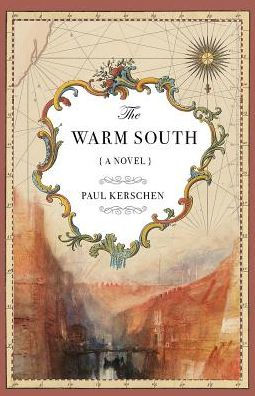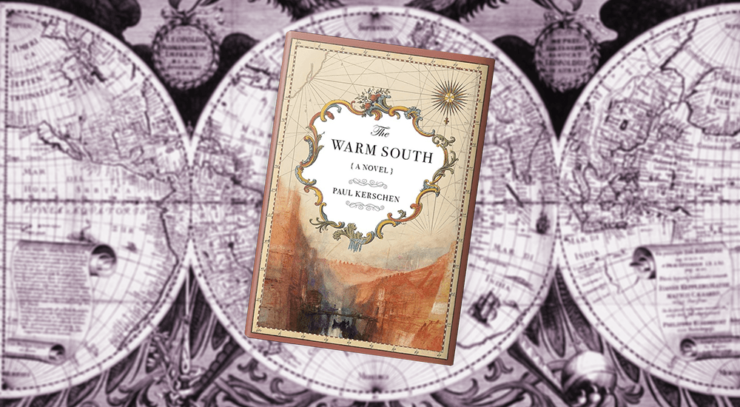This year, not even half over, has brought with it a number of novels in which alternate timelines play a crucial role. K Chess’s Famous Men Who Never Lived followed the lives of a group of refugees from an alternate Earth and their efforts to, in part, figure out exactly where their Earth’s timeline diverged from our own. Ian McEwan’s Machines Like Me posits that a world in which Alan Turing had not died in the 1950s would be one in which certain technological advances, from the internet to artificial humans, would be a part of the world by the 1980s. In both of these novels, like many alternate histories, the changes to the world are seismic; it’s easy to pinpoint just where things changed.
Paul Kerschen’s novel The Warm South also tells the story of a world in which something occurred differently than it did on our own. But it falls into a more modest scale: think of Bruce Sterling’s story “Dori Bangs,” or Kim Stanley Robinson’s “Remaking History.” In these stories, certain alterations to history as we know it have occurred, but the focus is less on dramatic social or political changes, but simply to how individual lives might have been altered in unexpected ways.
The Warm South hinges upon a single life: that of the English poet John Keats, who died in Rome in 1821. In Kerschen’s novel, Keats lives, and his brush with death sets him on a very different path than the one he’d previously walked. He embraces his studies of medicine again, eschewing poetry and the company of his friend, the writer Joseph Severn. And he ventures across 19th-century Italy—very much enmeshed in the process of shifting from a group of small countries into one unified nation—he becomes more embroiled in the region’s politics than he might have expected. In some ways, this is a novel about a young man questioning every aspect of his life in light of a brush with death. But given that that young man is John Keats, the consequences of his decisions bear abundant weight.
As befits a novel with a writer at its center, there’s also plenty of talk of books—some of it brilliantly wry. Much of the book concerns Keats’s interactions with Mary and Percy Bysshe Shelley. This, in turn, leads to one of the novel’s high points: when Mary hands Keats a draft of a novel she’s been working on dealing with another instance of a dead man returned to life.
“It was—well, it was poetry, in a way. But God, what had she given him for a ruling passion: grave robbing? Torturing dead flesh? He hadn’t thought her so ghoulish. Strange, pale woman.”
The process by which Keats comes to admire Frankenstein is one of several small joys to be found in this book and its subtle rewriting of history. But for every literary Easter egg situated here, there are also moments of raw emotion—notably, the ways in which Keats eludes both Severn and the other people to whom he was close. It’s a deeply personal stage on which these actions play out.
Buy the Book


The Warm South
Remember how I spoke of the modest scale of Kerschen’s novel earlier? I wasn’t lying—but it’s also easy to imagine the inciting event of this book leading to much larger historical changes down the line. Would a Keats who lived to a ripe old age still be the beloved romantic figure that he is today? Would he have influenced so many writers—including Jorge Luis Borges, who often spoke of Keats’s impact on him as a young writer? Kerschen also leaves implicit some of the other changes that Keats living might have prompted: namely, his closeness to the Shelleys. How might the presence of their friend over the years and decades to follow have reshaped their lives? And how, in turn, might those reshaped lives have altered literature, and aspects of culture in general?
In that way, The Warm South is a novel that casts its own more massive shadow. There’s a comedy of manners here among the intelligentsia of a certain time and place, but there are also hints of just how the smallest changes might impact the lives of many more people after a certain amount of time has passed. Kerschen’s novel is a subtle work, but it also implies its own sequel—a deft work of plotting, written with precision and emotion.
The Warm South is available from Roundabout Press.
Book cover: Roundabout Press; Background image: Johannes Kepler, 1627 (Public Domain)
 Tobias Carroll is the managing editor of Vol.1 Brooklyn. He is the author of the short story collection Transitory (Civil Coping Mechanisms) and the novel Reel (Rare Bird Books).
Tobias Carroll is the managing editor of Vol.1 Brooklyn. He is the author of the short story collection Transitory (Civil Coping Mechanisms) and the novel Reel (Rare Bird Books).











1821, not 1851. You had me wondering if I was in an alternate timeline.
Also, Percy Shelley died in 1822, so is this novel also a timeline where Percy lives a full life?
@1 – Corrected the year of Keats’s death, thanks.
@1 — it would be safe to say that Shelley’s life is one of several that’s affected by Keats’s survival in the timeline featured in this novel. To go into the specifics would venture into spoiler territory, however.